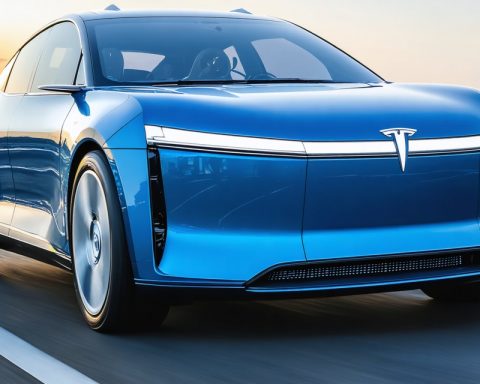- SpaceX launched 27 new Starlink satellites from Vandenberg Space Force Base to enhance global telecommunications.
- The Falcon 9 rocket’s first-stage booster successfully landed on a droneship, marking its fifth flight and highlighting reusable technology.
- Starlink aims to improve internet access worldwide, including in remote areas, revolutionizing global connectivity.
- Increased satellite presence poses challenges for astronomers, but SpaceX is working to mitigate reflective glare and space debris.
- This launch signifies a turning point in the cosmos exploration, emphasizing the blend of technological advancement and responsibility.
On a cool Thursday evening, just as the sun began to set over California’s rugged coast, the horizon lit up with the fiery plume of SpaceX’s Falcon 9 rocket. Departing from Vandenberg Space Force Base at precisely 6:02 p.m., the rocket embarked on a journey to introduce 27 more Starlink satellites into our crowded skies. This launch, initially delayed by two days, showcases both the marvels and the mysteries of modern space exploration.
Like a seasoned traveler, the first-stage booster of the Falcon 9 exhibited a well-earned patina, having journeyed to the stars four times previously. This reliable workhorse returned once more to the Earth, landing gracefully on a droneship awaiting patiently in the vast Pacific Ocean. Nearby residents felt the air shiver with a sonic boom, a thunderous reminder of humanity’s push to rise above the constraints of terrestrial life.
The story of this Falcon 9, however, stretches beyond the immediate spectacle of its launch. Above our heads, the sky has become a bustling thoroughfare, thanks to SpaceX’s ambitious Starlink project. The newly added constellations of satellites weave through the heavens, promising transformation in global telecommunications. With plans to improve internet access across the globe, even in the most remote regions, these satellites herald a shift in how we connect and communicate on our small planet.
Yet, the growing tapestry of orbiting technology also poses challenges, especially for astronomers who now navigate a celestial sphere increasingly dotted with man-made lights. SpaceX, in acknowledging this interference, has taken steps to minimize reflective glare. They are also ensuring these satellites do not contribute significantly to space debris, thereby safeguarding our vital space environment for future generations.
This captivating dance of technology and responsibility underscores a pivotal juncture in our exploration of the cosmos. SpaceX has not only reshaped the landscape of orbital launches with its reusable technology but also spearheaded a new era where accessibility to the digital realm is on the cusp of transformation.
As we gaze upward, our night sky is now a hub of human achievement, a testament to our unyielding quest to advance, connect, and explore. Each launch, every satellite, becomes part of a mosaic that tells the unfolding story of our reach for the stars, reminding us of the dynamic, interconnected future hurtling toward us at the speed of light.
SpaceX’s Starlink Constellation: Expanding Access and Managing Challenges
Introduction
On a serene evening in California, the horizon was illuminated by SpaceX’s Falcon 9 rocket as it embarked on a mission to deploy 27 more Starlink satellites into orbit. This launch from Vandenberg Space Force Base reflects both the extraordinary advancements and the intricate challenges of modern space exploration. This article examines the broader implications of SpaceX’s ambitious Starlink project and delves into the impact of the growing number of satellites on both technology and astronomy.
Key Facts about SpaceX’s Starlink Project
1. Reusable Rocket Technology: SpaceX’s Falcon 9 rocket, renowned for its reusable first-stage booster, showcases the company’s innovation in reducing launch costs and increasing mission frequency. This particular booster, having completed five missions, exemplifies the company’s successful strides in sustainable space travel.
2. Global Internet Access: Starlink aims to provide high-speed internet access globally, even in remote areas with little to no connectivity. This has significant implications for education, healthcare, and economic development, bridging the digital divide and enabling opportunities in underserved regions.
3. Astronomical Concerns: The proliferation of Starlink satellites, while beneficial, raises concerns among astronomers. The increased number of satellites can create light pollution, affecting ground-based astronomical observations. SpaceX has been working on reducing the satellites’ reflectivity to mitigate these effects.
4. Space Debris Management: SpaceX is actively seeking to address potential space debris issues by designing satellites that deorbit at the end of their operational life. This is crucial for preserving the space environment and ensuring future exploration missions can proceed without hindrance.
How-To Steps & Life Hacks
– Tracking Starlink: Amateur astronomers and enthusiasts interested in observing the Starlink constellation can use apps like Stellarium or websites like Heavens Above to predict satellite visibility in their location.
– Improving Connectivity: As Starlink expands, individuals in remote areas can consider signing up for Starlink internet to access reliable high-speed internet, which could be a game-changer for remote work and online education.
Market Forecasts & Industry Trends
– The satellite internet market is projected to grow significantly, with companies like Amazon and OneWeb also entering the space. This emerging sector promises increased competition, potentially driving down costs and improving service offerings.
Real-World Use Cases
– Emergency Connectivity: During natural disasters or infrastructure failures, Starlink can provide essential communication links for disaster response teams and affected communities.
– Remote Business Operations: Businesses operating in remote areas, such as mining and forestry, can utilize Starlink to facilitate communication and logistics.
Controversies & Limitations
– Regulatory Hurdles: Starlink faces regulatory challenges across different countries, with some regions raising concerns about frequency interference and national security.
Insights & Predictions
– Evolving Technology: As technology progresses, we can expect future iterations of Starlink satellites to become more efficient, with enhanced capacity and reduced environmental impact.
Actionable Recommendations
– Stay Informed: Regularly check updates from SpaceX and scientific communities to stay informed about the status and visibility of Starlink satellites.
– Mitigate Astronomical Impact: Support efforts to balance satellite deployment with the preservation of dark skies, crucial for both professional and amateur astronomical observations.
For more information, visit SpaceX.
By understanding the innovative yet complex nature of projects like Starlink, we can better appreciate the transformative potential of satellite technology while remaining mindful of its challenges and responsibilities. As humanity continues to push the boundaries of exploration and connectivity, thoughtful stewardship of our shared space environment is essential.











